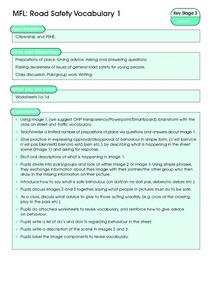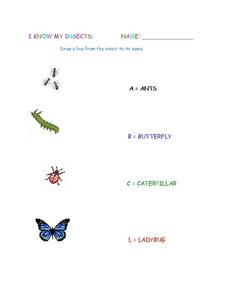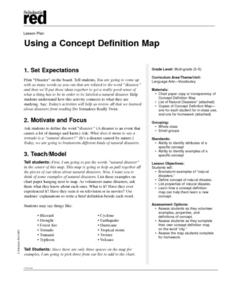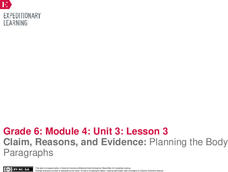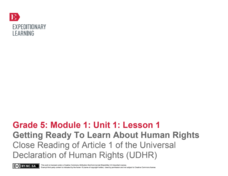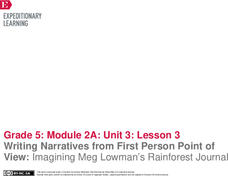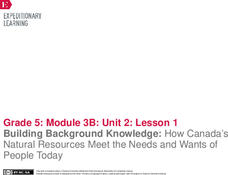Curated OER
Words in the News
Students discuss the topic of museums together in small groups. They identify and practice new vocabulary found in a newspaper article about a museum opening. They answer questions about the article as well.
Curated OER
Words In The News
Young scholars are asked to match the civil wars with the main dates they were fought. They work in groups and try to match the vocabulary with the definitions. Students work with other groups to pool their knowledge. They are told...
Curated OER
MFL: Road Safety Vocabulary 1
Students brainstorm any words they associate with traffic and safety. In groups, they work together to complete a worksheet identifying images. They also discuss what they would tell someone who was acting unsafely.
Curated OER
Using Recipes in the LCTL Classroom
Students in the English language learner classroom study and review food names, cooking verbs, units of measure, and cultural meals specific to the language they are learning. They practice using necessary words and terms for each area...
Curated OER
Describing Words
First graders brainstorm adjectives, recognize adjectives within text read by teacher, identify sentences that contain adjectives using Hyperstudio stack, and write two descriptive sentences for abstract image they create.
Curated OER
I Know My Insects!
In this insect matching worksheet, students identify the insect pictures and then draw a line from the insect to its name. Students match 4 insects.
Curated OER
Signs of the Wind
Students discover the properties of wind. They name as many wind words as they can. (breezy, windy, blustery, gust, tornado, hurricane, stormy, etc.) and use vocabulary, movement, and props to illustrate winter weather concepts such as...
Curated OER
Just Plain Fancy
Learners complete pre reading, writing, during reading, and interdisciplinary activities for the book Just Plain Fancy. In this reading lesson plan, students complete journal entries, go over vocabulary, answer short answer questions,...
Curated OER
Using a Concept Definition Map
Students define "natural disaster" by offering examples and charting them to discover what a concept definition map is. Then students create their own maps using the word "city".
Curated OER
Understanding the Body, Day 1: Anatomy
Intended for moderate to severely disabled students, this lesson focuses on building an understanding of human anatomy. A secondary special education class reviews, identifies, and labels parts of the body. Including the internal and...
Curated OER
English Lesson Plans for Grade 8
Demonstrate how to engage in a polite and professional conversation with this banking and interfacing instructional activity. Focusing on explanatory and informaitonal texts, middle schoolers write sentences using banking and finance...
EngageNY
Claim, Reasons, and Evidence: Planning the Body Paragraphs
Planning is the key to success. Scholars continue planning their essays by adding reasons to their Planning My Argument graphic organizers. Additionally, pupils analyze a body paragraph from a model position paper, identifying the...
EngageNY
Analyzing Images and Language: Inferring about the Natural Disaster in Eight Days
Pictures often reveal different meanings. Scholars analyze the images in Eight Days and discuss how they add meaning to the text. Readers answers questions about how specific colors are used to create different emotions. Learners then...
Curated OER
A News Story of Your Own: Sentence and Lexical Variety
Given the two-sentence skeleton of a news story about a car theft/joy ride, budding writers create their own version of the story varying diction and sentence structure to heighten interest and complexity in their writing. Resource...
EngageNY
Getting Ready to Learn About Human Rights: Close Reading of Article 1 of the Universal Declaration of Human Rights (UDHR)
Introduce young readers to informational texts with a well-designed, ready-to-use, and Common Core-aligned unit. Young readers learn a variety of skills while studying the Universal Declaration of Human Rights (UDHR). As the first...
EngageNY
Writing Narratives from First Person Point of View: Imagining Meg Lowman’s Rainforest Journal
I spy with my little eye! Learners observe page 23 in The Most Beautiful Roof in the World and practice what they would add to a field journal. They discuss how details from the text help add to their thoughts. To finish,...
EngageNY
Tracing and Evaluating Arguments: “The Future of Water” and The Big Thirst
Can scholars predict the future? They try as they first watch the video The Future of Water to capture details and trace the argument. Next, individuals complete the Tracing an Argument
note catcher to guide their thoughts. To...
EngageNY
Performance Task: Hosted Gallery Walk of Scientific Posters
The guests have arrived. Scholars participate in a hosted gallery walk, using their scientific posters to share their research about DDT with their classmates. Then, using sticky notes, individuals leave positive feedback on their peers'...
EngageNY
Applying Research Skills: “Rachel Carson: Environmentalist and Writer”
It's important to cite sources! Scholars take a closer look at their research about DDT by examining how to cite sources. Learners take turns sharing information that would be used to cite sources to complement Rachel Carson:...
EngageNY
Building Background Knowledge: How Canada’s Natural Resources Meet the Needs and Wants of People Today
Learners follow along as the teacher reads Products of Mining in Canada: From Batteries to Vehicles aloud. They then discuss the meaning of key terms and determine the gist of the text. Pupils do a second read and complete a graphic...
EngageNY
Researching about the Red Cross: What Is a Multinational Aid Organization?
Lend a helping hand. Pupils read two informational articles about international aid organizations and how they help areas affected by natural disasters. Scholars attempt to uncover the gist of each text, discussing their thoughts in...
EngageNY
End of Unit Assessment, Part II: Storyboard Draft, Sections 2 and 3
It's time to demonstrate knowledge. With the instructive resource, pupils complete the second part of the end of unit assessment. They develop sections two and three of their storyboards about an invention, add visual elements, and then...
EngageNY
End of Unit Assessment, Part III: Storyboard Draft, Section 4
Reflection is the best teacher. Using the resource, scholars complete the final part of their end of unit assessment, the fourth section of their storyboard about an invention. Next, they track their progress using a self-reflection...
Curated OER
Two Settings
Learners respond to the text Riding Freedom. They will compare and contrast two settings by filling in a graphic organizer. They explore different settings, discuss the reasons why settings change, and draw conclusions using descriptive...


